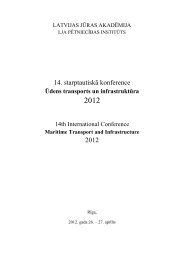Latvian Maritime academy
Latvian Maritime academy
Latvian Maritime academy
You also want an ePaper? Increase the reach of your titles
YUMPU automatically turns print PDFs into web optimized ePapers that Google loves.
typical frequencies higher for about 12..18%, that first of all is signalling about the weakening of the<br />
lubrication regime of the bearing. The growth of the amplitude of frequency №2 is the most visible that is<br />
signalling about the appearance of a single defect ont he running slot of the outside bearing ring.<br />
Appearing 2 defects a harmonics with double frequency is possible 4311 х 2 = 8622 Hz. For example, if<br />
the load of the induction motor is a piston compressor then the basic operation frequency of it is in the<br />
range (with the angular velocity 1420 min -1 ) 23…24 Hz. The signals with this frequency are filtered by<br />
the filter of lower frequencies.<br />
To find the correlation between the harmonics of the frequencies of the mechanical oscillations and<br />
those of the magnetic induction in air gap the demonstrated in Figure 3 scheme is proposed.<br />
Figure 3. Block-scheme of the experimental installation<br />
1 - fan; 2- electric motor; 3- piezo-accelerometer – the sensor of vibration; 4- the sensor of the angular velocity; 5 -<br />
band-pass filter; 6- filter of lower frequencies; 7 analogous-digital converter with the commutator at the input; 8-<br />
output to the computer; 9- sensors of current; А, В, С- supply voltage.<br />
The vibrations of the front panel of the electric motor are measured with piezo-accelerometer 3<br />
(Figure 3). The measured signal from it comes to analogue-digital converter 7. The angular velocity is<br />
measured by sensor 4. This sensor is installed inside the body of the fan and operates when the fan’s<br />
blades pass by it. The number of the fan’s blades and their step is known. Measuring the time interval of<br />
the blades passing by the sensor it is possible to measure the instant angular velocity and the instant<br />
acceleration of the motor shaft as well. In an ideal case the instant angular velocity per one turn of the<br />
rotor will be constant, and the acceleration will be zero. The defects of the bearing units cause the<br />
changing of the instant angular velocity and instant acceleration. The exceeding of these parameters over<br />
the preset bounds signals about an incipient defect of the bearing units. The signals from the sensors of<br />
current 9 firstly come to the band-pass filter 5. This filter is tuned for the frequencies range which should<br />
include also the informative (typical) frequency. Further the signals are supplied to the filter of lower<br />
frequencies 6 (it delays the electrical signals lower than a particular frequency) and then to analoguedigital<br />
converter 7. The information 8 from it does to the computer. The software includes a program of<br />
spectral analysis. The information is analysed determining the amplitude and frequency spectral range of<br />
the signals. The obtained results are saved and the compared with the further measurements. The spectral<br />
range of the consumed current is complicated in its nature including a large number of frequencies. But<br />
the changing of the typical frequencies is of the most interest. The appearance of new frequencies allows<br />
to judge the technical condition of the bearing unit. The sensor of angular velocity 4 has a digital output<br />
and is connected to the computer port passing by analogue-digital converter 7. Mechanical oscillations of<br />
the rotor cause periodic changes of the air gap size in the magnetic circuit of the electric machine. It<br />
results in the harmonics in the spectral component of magnetic induction. These changes in the<br />
amplitude-harmonic component of the induction cause the changes in that of the consumed current and<br />
voltage. Thus an unstable position of the rotor in the stator boring (mechanical harmonics) modulates the<br />
magnetic flux in the air gap. The frequency of new harmonics of magnetic flow can differ from the<br />
typical frequencies of the mechanical oscillations generated in bearings in 1-12 times [2]. The magnetic<br />
flux is modulated when the frequencies are added as well as subtracted.<br />
In general case the spectral component of the consumed current and voltage can be represented as a<br />
sum of harmonics with different frequencies and phases:<br />
12
















